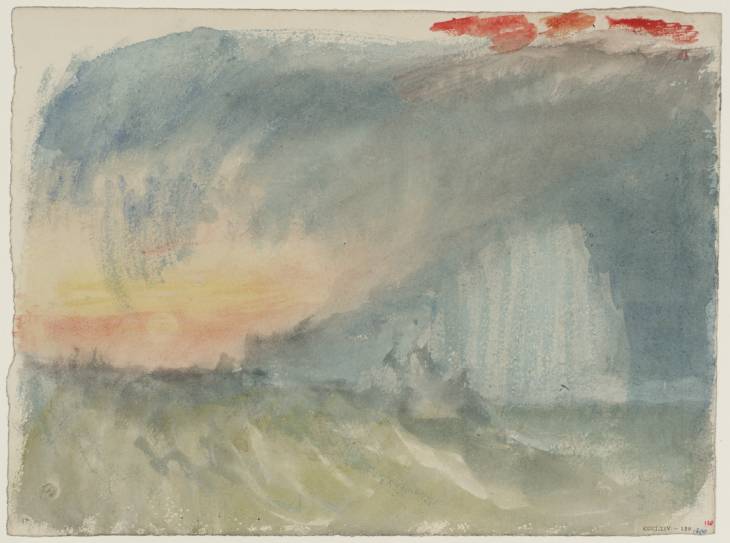Joseph Mallord William Turner The Bass Rock c.1824
Joseph Mallord William Turner,
The Bass Rock
c.1824
Joseph Mallord William Turner 1775–1851
The Bass Rock c.1824
D35973
Turner Bequest CCCLXIV 130
Turner Bequest CCCLXIV 130
Watercolour on white wove paper, 219 x 294 mm
Blind-stamped with Turner Bequest monogram towards bottom right
Inscribed in red ink ‘130’ bottom right
Stamped in black ‘CCCLXIV – 130’ bottom right
Blind-stamped with Turner Bequest monogram towards bottom right
Inscribed in red ink ‘130’ bottom right
Stamped in black ‘CCCLXIV – 130’ bottom right
Accepted by the nation as part of the Turner Bequest 1856
Exhibition history
1974
Turner and Watercolour: An Exhibition of Watercolours Lent from the Turner Bequest at the British Museum, Arts Council tour, Herbert Art Gallery & Museum, Coventry, April 1974, Graves Art Gallery, Sheffield, May, Castle Museum, Norwich, June, City Art Gallery, Leeds, June–July, City Art Gallery, Bristol, July–August, Towner Art Gallery, Eastbourne, August–September (35, as ‘Staffa (?)’, c.1831).
1997
Turner’s Watercolour Explorations 1810–1842, Tate Gallery, London, February–June 1997, Southampton City Art Gallery, June–September (36, as ‘The Bass Rock’, c.1824, reproduced in colour).
1999
Turner and Sir Walter Scott: The Provincial Antiquities and Picturesque Scenery of Scotland, National Gallery of Scotland, Edinburgh, December 1999–March 2000 (37, as ‘Colour Study of The Bass Rock’, c.1824, reproduced in colour).
2013
Turner from the Tate: The Making of a Master, Art Gallery of South Australia, Adelaide, February–May 2013, National Gallery of Australia, Canberra, June–September (77, as ‘The Bass Rock’, c.1824, reproduced in colour).
2014
Turner from the Tate: The Making of a Master, Tokyo Metropolitan Art Museum, October – December 2013, Kobe City Museum, January–April 2014 (72, as ‘The Bass Rock’, 1824, reproduced in colour).
References
1830
A.J. Finberg, A Complete Inventory of the Drawings of the Turner Bequest, London 1909, vol.II, p.1184, CCCLXIV 130, as ‘Sea piece: Stormy Evening’, after c.1830.
1831
John Gage, Turner and Watercolour: An Exhibition of Watercolours Lent from the Turner Bequest at the British Museum, exhibition catalogue, Herbert Art Gallery & Museum, Coventry 1974, p.46 no.35, as ‘Staffa (?)’, c.1831.
1824
Eric Shanes, Turner’s Watercolour Explorations 1810–1842, exhibition catalogue, Tate Gallery, London 1997, p.57 no.36, as ‘The Bass Rock’, c.1824, reproduced in colour, 101 Appendix I ‘Scotland’.
1824
Katrina Thomson, Turner and Sir Walter Scott: The Provincial Antiquities and Picturesque Scenery of Scotland, exhibition catalogue, National Gallery of Scotland, Edinburgh 1999, pp.31, 94 no.37, as ‘Colour Study of The Bass Rock’, c.1824, reproduced in colour, pl.19.
1824
Sam Smiles, J.M.W. Turner, British Artists, London 2000, fig.27 (colour), as ‘The Bass Rock’, c.1824.
In a first attempt to identify the subject of this ‘colour beginning’ described by Finberg as a ‘Sea piece: Stormy Evening’,1 John Gage tentatively suggested Staffa,2 the rocky island of the Inner Hebrides which Turner visited on his Scottish tour of 1831; he exhibited the loosely comparable painting Staffa, Fingal’s Cave the following year, with its dramatic sunset and towering clouds dwarfing a steamship on a dark sea (Yale Center for British Art, New Haven).3 In fact, the work appears rather to be a contemporary variant of Tate D25327 (Turner Bequest CCLXIII 205), a study related to The Bass Rock, a watercolour of about 1824 (Lady Lever Art Gallery, Port Sunlight)4 showing the island in the Firth of Forth, which was engraved in 1826 for Walter Scott’s Provincial Antiquities of Scotland (see the Introduction to this section; Tate impressions: T04499–T04501, T06066).
While the finished design appears to rely particularly on 1822 drawings from the south as noted under D25327, Eric Shanes has stated that the version here is based on two of the many views in the 1818 Bass Rock and Edinburgh sketchbook (Tate D13326, D13330; Turner Bequest CLXV 3a, 5a),5 from a more south-easterly angle, although the correlations are not exact and the differences more perhaps on account of the looseness of the two colour studies than deliberate changes of viewpoint. Shanes has suggested that the marks below the middle of the rock may indicate ‘a foundering vessel’,6 perhaps prefiguring the prominent wreckage in the foreground of the finished design.
As Katrina Thomson has put it, Turner is also ‘playing with different effects of atmosphere and light’,7 most obviously in showing a yellow and red sunset sky to the left of the rock8 (with undiluted red test strokes at the top right), as opposed to the strong blues of the lightning-riven, stormy sky opted for in the end.
Verso:
Blank
Matthew Imms
July 2016
How to cite
Matthew Imms, ‘The Bass Rock c.1824 by Joseph Mallord William Turner’, catalogue entry, July 2016, in David Blayney Brown (ed.), J.M.W. Turner: Sketchbooks, Drawings and Watercolours, Tate Research Publication, February 2017, https://www

